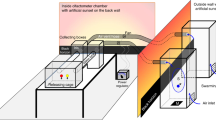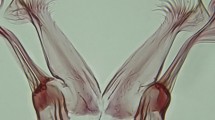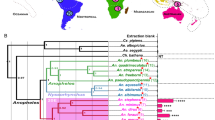Abstract
Despite the benefits of multiple mating to females many mosquitoes appear to be monandrous. Members of the mosquito tribe Sabethini are unique among the mosquitoes for they possess iridescent scales and elaborate ornaments in both sexes. Additionally, this tribe boasts the only reported cases of courtship display within the mosquitoes. Due to these singular traits and behaviors, we predicted that members of this tribe have a different mating system with relatively high female mating rate. We tested this prediction in the ornamented mosquito Sabethes cyaneus. Contrary to our prediction, however, females were monandrous throughout their lifetime and multiple gonotrophic cycles. We discuss the possible implications of monandry on the evolution of sexually homologous ornaments, with particular consideration of mutual mate choice.


Similar content being viewed by others
References
Amundsen T (2000) Why are female birds ornamented? Trends Ecol Evol 15:149–155
Arnqvist G (1989) Multiple mating in a water strider: mutual benefits or intersexual conflict? Anim Behav 38:749–756
Arnqvist G, Andrés JA (2006) The effects of experimentally induced polyandry on female reproduction in a monandrous mating system. Ethology 112:748–756
Arnqvist G, Nilsson T (2000) The evolution of polyandry: multiple mating and female fitness in insects. Anim Behav 60:145–164
Baimai V, Green CA (1987) Monandry (monogamy) in natural populations of anopheline mosquitoes. J Am Mosq Control Assoc 3:481–484
Becker N, Petric D, Zgomba M, Boase C, Dahl C, Lane J, Kaiser A (2003) Mosquitoes and their control. Kluwer Academic/Plenum, New York
Bonduriansky R (2001) The evolution of male mate choice in insects: a synthesis of ideas and evidence. Biol Rev 76:305–339
Bryan JH (1968) Results of consecutive matings of female Anopheles gambiae species B with fertile and sterile males. Nature 218:489
Bullini L, Coluzzi M, Bianchi Bullini AP (1976) Biochemical variants in the study of multiple insemination in Culex pipiens L. (Diptera: Culicidae). Bull Entomol Res 65:683–685
Clements AN (1999) The biology of mosquitoes. CABI, Wallingford, UK
Coyne JA, Orr HA (2004) Speciation. Sinauer, Sunderland, Massachusetts
Craig GB (1967) Mosquitoes: female monogamy induced by male accessory gland substance. Science 156:1499–1501
Crow JF (1958) Some possibilities for measuring selection intensities in man. Hum Biol 30:1–13
Crow JF (1991) Fitness variation on natural populations. In: Hill WG, Mackay TFC (eds) Evolution and animal breeding systems. CAB International, Wallingford, pp 91–97
Crudgington HS, Siva-Jothy MT (2000) Genital damage, kicking and early death: the battle of the sexes takes a sinister turn in the bean weavil. Nature 407:855–856
Darwin C (1871) The descent of man, and sexual selection in relation to sex. Murray, London
Eberhard WG (1996) Female control: sexual selection by cryptic female choice. Princeton University Press, Princeton, New Jersey
George JA (1967) Effect of mating sequence on egg-hatch from female Aedes aegypti (L) mated with irradiated and normal males. Mosq News 27:82–86
Gillies MT (1956) A new character for the recognition of nulliparous females of Anopheles gambiae. Bull World Health Organ 15:451–459
Goma LKH (1963) Tests for multiple insemination in Anopheles gambiae Giles. Nature 197:99–100
Gwadz RW, Craig GB (1970) Female polygamy due to inadequate semen transfer in Aedes aegypti. Mosq News 30:355–360
Haddow AJ, Corbet PS (1961) Entomological studies from a high tower in Mpanga Forest, Uganda. V. Swarming activity above the forest. Trans R Entomol Soc Lond 113:284–300
Hancock RG, Foster WA, Yee WL (1990a) Courtship behavior of the mosquito Sabethes cyaneus (Diptera: Culicidae). J Insect Behav 3:401–416
Hancock RG, Yee WL, Foster WA (1990b) Tests of Sabethes cyaneus leg paddle function in mating and flight. J Am Mosq Control Assoc 6:733–735
Harbach RE (1991) A new subgenus of the genus Sabethes (Diptera: Culicidae). Mosq Syst 23:1–9
Harbach RE, Petersen JL (1992) Two species previously confused under the concept of Sabethes tarsopus in Central America (Diptera: Culicidae). Mosq Syst 24:102–124
Huxley JS (1914) The courtship habits of the great crested grebe (Podiceps cristatus); with and addition to the theory of sexual selection. Proc Zool Soc Lond 35:491–562
Jennions MD, Petrie M (2000) Why do females mate multiply? A review of the genetic benefits. Biol Rev 75:21–64
Jones JC (1973) Are mosquitoes monogamous? Nature 242:343–344
Jones IL, Hunter FM (1993) Mutual sexual selection in a monogamous seabird. Nature 362:238–239
Judd DD (1996) Review of the systematics and phylogenetic relationships of Sabethini (Diptera: Culicidae). Syst Entomol 21:129–150
Kemp DJ, Rutowski R (2004) A survival cost to mating in a polyandrous butterfly, Colias eurytheme. OIKOS 105:65–70
Klowden MJ (1999) The check is in the male: male mosquitoes affect female physiology and behavior. J Am Mosq Control Assoc 15:213–220
Kraaijeveld K, Gregurke J, Hall C, Komdeur J, Mulder RA (2004) Mutual ornamentation, sexual selection, and social dominance in the black swan. Behav Ecol 15:380–389
Lande R (1980) Sexual dimorphism, sexual selection, and adaptation in polygenic characters. Evolution 34:292–305
Lande R (1987) Genetic correlations between the sexes in the evolution of sexual dimorphism and mating preferences. In: Bradbury JW, Andersson MB (eds) Sexual selection: testing the alternatives. Wiley, Chichester, UK, pp 83–95
Lande R, Arnold SJ (1985) Evolution of mating preference and sexual dimorphism. J Theor Biol 117:651–664
Mahmood F, Reisen WK (1980) Anopheles culicifacies: the occurrence of multiple insemination under laboratory conditions. Entomol Exp Appl 27:69–76
Martens A, Rehfelt G (1989) Female aggregation in Platycypha caligata (Odonta: Chlorocipidae): a tactic to evade male interference during oviposition. Anim Behav 38:369–374
Okazawa T, Horio M, Suzuki H, Mogi M (1986) Colonization and laboratory bionomics of Topomyia yanbarensis (Diptera: Culicidae). J Med Entomol 23:493–501
Payne RB (1979) Sexual selection and intersexual differences in variance in breeding success. Am Nat 114:447–466
Philips TK, Hancock RG, Foster WA (1996) Epigamic display and unique mating position in Wyeomyia arthrostigma (Diptera: Culicidae). J Insect Behav 9:739–753
Reisen WK, Evans BG, Bock ME (1984) Reinsemination of parous Culex tarsalis females. Mosq News 44:580–582
Rowe L (1992) Convenience polyandry in a water strider: foraging conflicts and female control of copulation frequency and guarding duration. Anim Behav 44:189–202
Servedio MR, Lande R (2006) Population genetic models of male and mutual mate choice. Evolution 60:674–685
Shannon RC (1931) On the classification of Brazilian Culicidae with special reference to those capable of harboring the yellow fever virus. Proc Entomol Soc Wash 33:125–164
Shuster SM, Wade MJ (2003) Mating systems and strategies. Princeton University Press, Princeton, New Jersey
Simmons LW (2001) Sperm competition and its evolutionary consequences in the insects. Princeton University Press, Princeton, New Jersey
Siva-Jothy MT (2000) The young sperm gambit. Ecol Let 3:172–174
Thornhill R, Alcock J (1983) The evolution of insect mating systems. Harvard University Press, Cambridge, Massachusetts
Välimäki P, Kaitala A, Kokko H (2006) Temporal patterns in reproduction may explain variation in mating frequencies in the green-veined white butterfly Pieris napi. Behav Ecol Sociobiol 61:99–107
Wade MJ, Arnold SJ (1980) The intensity of sexual selection in relation to male sexual behaviour, female choice, and sperm precedence. Anim Behav 28:446–461
Wedell N (1997) Ejaculate size in bushcrickets: the importance of being large. J Evol Biol 10:315–325
Wiklund C, Karlsson B, Leimar O (2001) Sexual conflict and cooperation in butterfly reproduction: a comparative study of polyandry and female fitness. Proc R Soc Lond B Bio Sci 268:1661–1667
Williams RW, Berger A (1980) The relation of female polygamy to gonotrophic activity in the ROCK strain of Aedes aegypti. Mosq News 40:597–604
Young ADM, Downe AER (1982) Renewal of sexual receptivity in mated female mosquitoes Aedes aegypti. Physiol Entomol 7:467–471
Yuval B, Fritz GN (1994) Multiple mating in female mosquitoes—evidence from a field population of Anopheles freeborni (Diptera: Culicidae). Bull Entomol Res 84:137–140
Zsemlye JL, Hancock RG, Foster WA (2005) Analysis of a complex vertical copulatory-courtship display in the yellow fever vector Sabethes chloropterus. Med Vet Entomol 19:276–285
Acknowledgments
Sincerest thanks to R. G. Hancock and W. A. Foster for providing us with the S. cyaneus colony used here and for rearing advice. Thank you also to B. Stenerlöw at the Division of Biomedical Radiation Sciences, Uppsala University for allowing us to use the caesium source. This study was made possible by financial support from The Swedish Research Council (G.A.) and Zoologiska Stiftelsen (S.S.).
Author information
Authors and Affiliations
Corresponding author
Rights and permissions
About this article
Cite this article
South, S.H., Arnqvist, G. Evidence of Monandry in a Mosquito (Sabethes cyaneus) with Elaborate Ornaments in Both Sexes. J Insect Behav 21, 451–459 (2008). https://doi.org/10.1007/s10905-008-9137-0
Revised:
Accepted:
Published:
Issue Date:
DOI: https://doi.org/10.1007/s10905-008-9137-0




